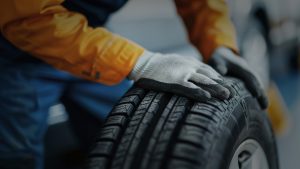
The Importance of Regular Tyre Checks: Booking and Preparing Your Subaru
Your tyres are the only point of contact between your Subaru and the road, making them a crucial factor in safety, performance, and fuel efficiency. Worn or underinflated tyres can compromise handling, increase stopping distances, and reduce fuel economy.
At Subaru, safety and reliability are at the heart of every vehicle. Subaru’s Symmetrical All-Wheel Drive system relies on well-maintained tyres to deliver optimal traction and stability. This makes regular tyre checks an essential part of vehicle upkeep.
Ignoring tyre maintenance can lead to costly repairs, poor handling, and even dangerous driving conditions. By keeping your tyres in top shape, you ensure a smoother, safer drive—whether you’re navigating city streets or heading off on an adventure.
Understanding Tyre Wear and Indicators
What is a Tyre Wear Indicator?
Tyre wear indicators are built-in safety markers designed to help drivers assess tread depth. These small ridges inside the tyre grooves become visible when the tread wears down to 1.6mm—the legal minimum in South Africa. Driving on worn tyres reduces grip, particularly on wet roads, increasing the risk of accidents.
Regular checks can help identify when it’s time to replace your tyres before they become a hazard.
How to Check Tyre Wear at Home
While a professional inspection is always recommended, you can perform simple checks at home:
- The Coin Test: Insert a R5 coin into the tyre tread. If the outer rim of the coin remains visible, your tread depth may be too low.
- Visual Inspection: Look for uneven wear patterns, cracks, or embedded objects that could compromise performance.
Common Signs of Tyre Wear
Be on the lookout for:
- Uneven wear patterns – Could indicate poor alignment or underinflation.
- Cracks or bulges – Signs of ageing or potential tyre failure.
- Reduced grip in wet conditions – Worn tyres increase the risk of hydroplaning.
The Subaru Approach to Tyre Maintenance
How Subaru Ensures Safe Tyres
Subaru vehicles are designed with safety at their core, and tyres play a critical role in maintaining stability and control. The advanced Symmetrical All-Wheel Drive (AWD) system distributes power evenly across all four wheels, meaning tyre condition directly affects performance.
When you service your Subaru at an authorised dealership, technicians inspect your tyres using state-of-the-art equipment to ensure optimal condition.
Why Subaru Recommends Regular Tyre Checks
Maintaining properly inflated and correctly aligned tyres improves:
- Fuel efficiency: Underinflated tyres increase rolling resistance, causing higher fuel consumption.
- Braking performance: Adequate tread depth reduces stopping distances, especially in wet conditions.
- Tyre lifespan: Routine maintenance prevents uneven wear, prolonging tyre durability.
Preparing for a Tyre Inspection with Subaru
Scheduling a professional tyre check is easy. Simply book a service online or visit your nearest Subaru dealership. Subaru-trained expert technicians will assess your tyres and provide recommendations tailored to your driving needs.
What Happens During a Tyre Inspection?
A Subaru-approved tyre inspection includes:
- Tread depth measurement – Ensuring legal and safe tyre wear levels.
- Tyre pressure check – Adjusting inflation to manufacturer specifications.
- Wheel alignment and balancing – Preventing uneven wear and improving stability.
- Visual assessment – Checking for sidewall damage, punctures, and cracks.
Benefits of Booking Through Subaru
By choosing a Subaru dealership, you receive:
- Access to genuine Subaru parts designed for your model.
- Subaru-trained technicians who work exclusively on Subaru vehicles.
- Comprehensive inspections that go beyond just tyre checks.
Best Practices for Tyre Maintenance
To maximise tyre lifespan and performance, follow these tips:
- Maintain correct tyre pressure – Under or overinflated tyres wear unevenly and affect handling.
- Rotate tyres every 10,000 km – This promotes even wear across all four tyres.
- Check wheel alignment annually – Misalignment causes uneven wear and reduces efficiency.
- Avoid sudden braking or sharp turns – These actions accelerate tyre deterioration.
When to Replace Your Tyres
Subaru recommends replacing tyres when:
- Tread depth is below 1.6mm – This is the legal minimum, but for optimal safety, replace them before reaching this point.
- You experience excessive road noise or vibration – This could indicate internal tyre damage.
- Tyres show cracks, bulges, or persistent loss of pressure.
Delaying replacement increases the risk of punctures, hydroplaning, and poor handling—compromising the safety of you and your passengers.
Frequently Asked Questions
- How do I know if my Subaru’s tyres need replacing?
Check the tread wear indicators and look for signs of cracking or bulging. If in doubt, visit a Subaru service centre for an inspection. - Can I check tyre wear without special tools?
Yes! Use the coin test or inspect the tread wear indicators built into your tyres. - How often should I schedule a tyre inspection for my Subaru?
Subaru recommends tyre checks at least once every six months or during regular servicing. You should also inspect your tyres before long road trips. - Does Subaru offer tyre maintenance as part of routine service?
Yes, Subaru’s routine service packages include tyre inspections, pressure checks, and alignment assessments. - What tyre brands does Subaru recommend for replacements?
Subaru-approved brands ensure optimal performance for your specific model. Speak to your Subaru dealership for recommendations tailored to South African road conditions.
Regular tyre maintenance is essential for safety, fuel efficiency, and overall driving performance. Whether you’re navigating city roads, heading on a road trip, or exploring off-road trails, well-maintained tyres are key to getting the best out of your Subaru.
Schedule your next tyre check with Subaru’s expert service team and ensure every journey is a safe one.
For more tips on car safety, visit Subaru’s travel insights and normalise regular vehicle inspections before every drive.